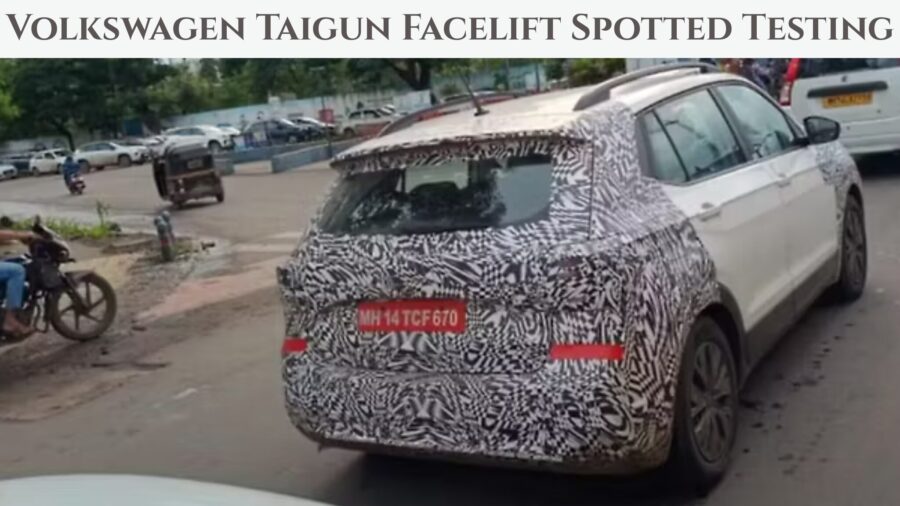4-Point Overview:
- Mid-life facelift of the Taigun spotted testing for the first time
- Visual updates at the front and rear, aligning with VW’s global SUV styling
- Interior to receive feature-rich upgrades, including Level 2 ADAS
- No changes to platform or engines — still underpinned by MQB A0-IN architecture
Introduction:
Volkswagen is preparing to refresh one of its most important models for India — the Taigun, first launched in September 2021. While the Skoda Kushaq facelift already made waves, it was only a matter of time before its German cousin followed suit. The Taigun facelift has now been caught testing, and although changes are evolutionary, they’re aimed at keeping the compact SUV in the game amid rising competition. Let’s break down everything that’s new and everything that’s staying put.


Familiar Bones, Fresh Looks
Volkswagen Taigun facelift sticks to its roots — quite literally. It continues to ride on the MQB A0-IN platform, the same as the Skoda Kushaq, Slavia, Kylaq and VW Virtus. That means the dimensions, suspension, and overall driving dynamics will remain familiar.
But the big news lies on the surface. The facelift brings restyled front and rear ends, with sharper elements and revised LED signatures to better reflect Volkswagen’s global SUV language. While the test car remains camouflaged, you can expect tweaks to the grille, bumpers, and tail-lamps.
Interestingly, one detail not seen on the test mule was the panoramic sunroof — raising questions on whether it will be available or reserved for higher trims.
Interior Upgrade: Tech Takes the Lead
Volkswagen is clearly upping its game inside the cabin. The facelifted Taigun is expected to come with a significant boost in tech and usability, ensuring it doesn’t fall behind Korean and Japanese rivals.
The biggest expected change?
Level 2 ADAS features. This will be a first for the Taigun and a huge leap in safety and driver assistance tech. Anticipated features include:
- Adaptive Cruise Control
- Lane Keep Assist & Lane Departure Warning
- Autonomous Emergency Braking
- Rear Cross-Traffic Alert
These additions are a clear signal that VW is taking Indian buyers’ expectations seriously, especially with ADAS becoming a segment trend.
Under the Hood: No Surprises, and That’s Okay
Mechanically, there’s no change — and that’s not a bad thing. The Taigun will continue to be powered by:
- A 1.0L TSI turbo petrol (115 PS / 178 Nm)
- A 1.5L TSI EVO turbo petrol (150 PS / 250 Nm)
Transmission options remain the same:
- 6-speed manual
- 6-speed torque converter automatic (1.0L)
- 7-speed DSG (1.5L)
There’s also talk of an 8-speed automatic being under consideration, though it might debut at a later stage.
Facelift with a Future
While this update keeps the Taigun fresh, Volkswagen is already thinking ahead. Skoda has confirmed that the next-gen Kushaq will debut around 2027, and it’s logical to expect the Taigun to follow closely. That model could bring a three-row version and more radical changes much like how Hyundai has the Creta and Alcazar relationship.
For now, this facelift is a strategic update — modernizing the Taigun while staying true to what made it successful in the first place.
Quick Glance: Taigun Facelift
| Category | Details |
|---|---|
| Platform | MQB A0-IN (no change) |
| Engines | 1.0L TSI (115 PS), 1.5L TSI EVO (150 PS) |
| Transmissions | 6MT, 6AT, 7DSG; possible future 8AT |
| Exterior Updates | Front & rear facelift, new lighting design |
| ADAS Features Expected | Adaptive Cruise, AEB, Lane Assist, Rear Cross Alert |
| Panoramic Sunroof | Not seen on test mule (unclear availability) |
| Launch Timeline | Expected sometime in early or mid 2026 |
Conclusion: Evolution, Not Revolution
The 2026 Volkswagen Taigun facelift isn’t trying to reinvent the wheel. Instead, it brings thoughtful updates — sharper styling, feature-rich interiors, and advanced driver assists — all while sticking to the tried-and-tested formula that Indian buyers already trust.
With rivals offering more tech and flair, this update gives the Taigun just enough muscle to hold its ground. And if ADAS does arrive as expected, it’ll mark a turning point for Volkswagen India — showing they’re ready to play offense, not just defense.
Image Source: Image — Jeevan Kammar

